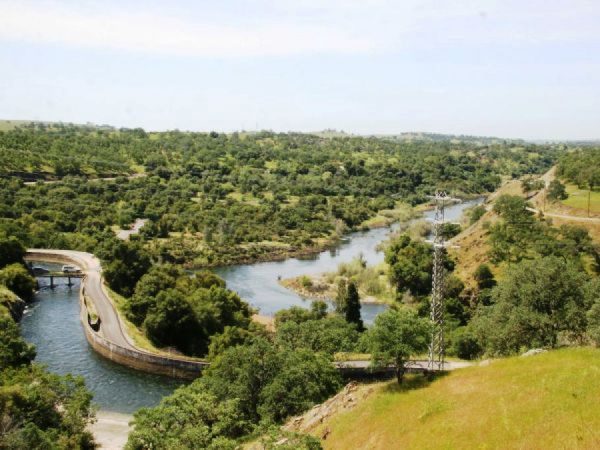TID Makes Case For River Flows
In a battle between fish and farmers for Tuolumne River water, the Turlock Irrigation District believes it has science on its side.
A State Water Resources Control Board plan would require the Turlock and Modesto Irrigation Districts to send 35 percent of Tuolumne River flows from February 1 through June 30 down the river, losing hundreds of thousands of acre-feet of irrigation water they would have otherwise diverted to Don Pedro Reservoir.
But TID made its case at a water board hearing last week that the proposal would irreversibly harm the local economy, while doing little to increase fish populations.
According to TID Director and Board Chairman Michael Frantz, the district and its partners presented “a tremendous amount” of scientific data in making its case – something the opposing environmental and fishing groups failed to do.
“They did not talk much about discrediting the sound science we presented, they just continued to make their case more on emotion than fact,” Frantz said.
Do Fish Need Water, Or Are Predators At Fault?
The water argument hinges on salmon populations, which have unarguably decreased substantially over the past century. Those ocean salmon swim through the delta, then up rivers like the Tuolumne River to birth their young in gravel river beds.
In large part, the district argues that non-native invasive fish species are responsible for the decline in salmon populations. According to TID research, 93 percent of juvenile salmon deaths on the Tuolumne River are caused by predation from non-native fish species like striped bass, rather than insufficient water flows.
But fishermen and environmental groups say fault for declining fish populations rests solely on restricted water flows, diminished from their natural levels by the construction of dams like TID's Don Pedro Reservoir.
If rivers have more water, they argue, more fish would successfully make spawning runs. The groups argue that even more water is needed than the water board's suggested 35 percent.
“The majority of the fish agencies and special interest groups representing various fishing interests or alliances felt that the 35 percent number was far too low,” Frantz said.
Those groups would like to see TID and MID relinquish 50 to 65 percent of flows, regardless of the potential impacts to the community.
Even a 35 percent cut to available water could be devastating for local farmers.
The San Joaquin Tributaries Authority, a coalition of water agencies including TID, estimates that in dry years over 220,000 acres of land in the Turlock, Modesto, and Merced Irrigation Districts – out of 319,000 acres serviced – would sit fallow. SJTA projects the water loss would lead to a $187 million economic impact in dry years, including the loss of over 1,200 jobs and 800 family farms.
All the while, environmental and fish groups failed to provide any firm estimates – or even shots in the dark – as to how much salmon populations might increase should additional flows be provided.
“They had no ability to quantify,” Frantz said. “It was just a guessing game.”
Drinking Water Availability Could Be Lessened
Though the district's arguments on economic impacts and non-native fish populations may have been expected, the proposal's potential impacts on drinking water seemed to take the water board by surprise, Frantz said.
Local communities – including Turlock – rely on groundwater for their drinking water supplies. Should the available irrigation water be reduced, less water will filter down to replenish aquifers each year, reducing available drinking water. Making matters worse, many farmers would look to pump groundwater to supplement reduced irrigation water, putting a further drain on aquifers.
The City and County of San Francisco's close working relationship with TID and MID also seemed to surprise the water board.
San Francisco, TID, and MID all share the Tuolumne River's flows, with San Francisco's Hetch Hetchy Reservoir providing 25 percent of the region's drinking water supply. In hopes of avoiding conflicts, the water board arbitrarily drew the project study boundary omitting Hetch Hetchy Reservoir, excluding San Francisco from the diversion requirements.
But San Francisco has longstanding operating agreements with TID and MID that make impacts unavoidable, potentially jeopardizing drinking water availability for the region.
Many Speakers, No Water Board Comment
Myriad elected officials spoke at the hearing in support of TID, from Assemblyman Adam Gray (D-Merced) to State Sen. Anthony Cannella (R-Ceres), State Sen. Tom Berryhill (R-Modesto), Stanislaus County Supervisor Vito Chiesa, and Turlock Mayor John Lazar. Local agribusinessmen spoke as well, like Mike Marsh, CEO of Western United Dairymen, Bill Mattos, President of the California Poultry Federation, and Mike Brem, President of SupHerb Farms.
Family farmers, too, spoke passionately about the proposal's potential impacts.
Water board members did not directly respond to the information heard last week but will consider the comments as they near a final ruling on the proposal. The TID expects to the water board to reach a final ruling by the end of 2013, possibly as soon as the end of summer.
“We need to trust the process and hope that they find our viewpoint and our perspective to be compelling,” Frantz said.
If not, the matter will likely end up in court. The SJTA's legal counsel has previously stated that legal action will likely come “early and often,” It could take as long as 15 years before the matter is decided in court, he said.
Related Aricles:
State Mandated Irrigation Water Cut Could Shutter Family Farms in Turlock Irrigation District







